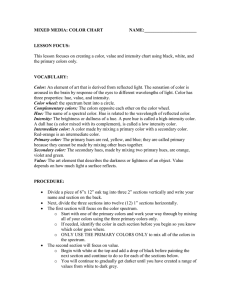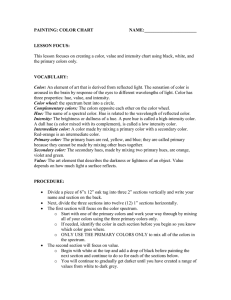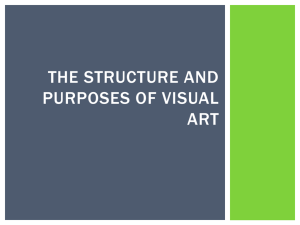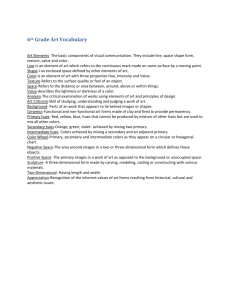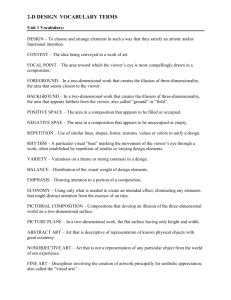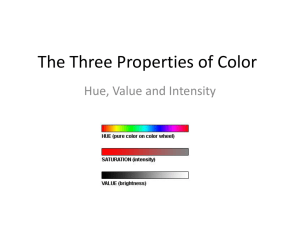The Elements of Design: Color Floral Design
advertisement
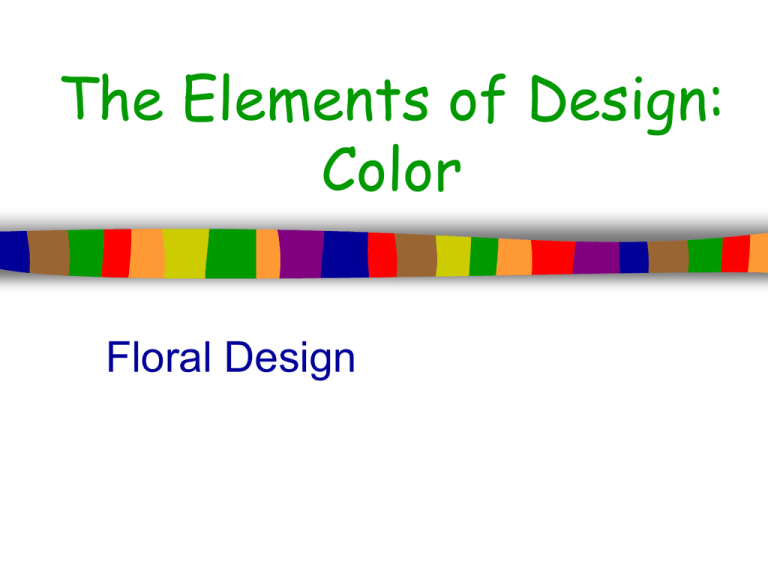
The Elements of Design: Color Floral Design Color What is color? – Color is an element of art that is derived from reflected light. • It is the most expressive element of art • It shares a powerful connection to emotion – Color Spectrum is when light passes through a wedge shaped glass, called a prism, and the beam of white light is bent and separated into bands of color. Hue What is hue? – Hue is the name of a color in the color spectrum. – There are various levels of classifying hues: • Primary hues include red, blue and yellow. They are used (with black and white) to make every other color. These primary hues cannot be made by mixing other hues together. • Secondary hues include orange, violet, and green. These are made by mixing 2 primary hues together (red + blue = violet, red + yellow = orange, blue + yellow = green). • Intermediate (or tertiary) hues are made by mixing 1 primary hue with its secondary hue. (red + orange = red-orange). Color Wheel What is a color wheel? – A color wheel is the spectrum of hues bent into a circle. • It includes 12 parts: – 3 primary colors – 3 secondary colors – 6 intermediate (tertiary) colors The Color Wheel Combining Primary Hues to make the Secondary Hues Activity! Design your own color wheel! Use only the primary colors to create all 12 hues. Paint on the card stock paper, fill in the color wheel exactly as the example. Be sure your hues are in the right place! Color Perception Your eye has a memory! When it sees a bold or bright color, it will recall that shape and color. On the next slide you will see a figure, and then when the figure is removed, your eye will still see it. Try it! Value What is value? – Value is the art element that describes the darkness or lightness of a color. • Yellow is the lightest hue because it reflects the most light • Violet is the darkest hue because it reflects the least light • Black, White, Grey are neutral colors Changing Value You can change the value of any hue by adding black or white: – Tint – a light value of a hue (adding white) – Shade – a dark value of a hue (adding black) Tints vs. Shades Tint: A hue’s lighter value, created by adding white Shade: A hue’s darker value, created by adding black Intensity What is Intensity? – Intensity is the brightness or dullness of a hue. • High intensity colors – from pure or bright hues • Low intensity colors – from dull hues – Adding the complementary color to a hue will change its intensity. Activity Choose one hue (use a colored pencil) and color in all the boxes with the pure hue. Then add white to the first box to create a tint. Then add black to the third box to create a shade. Warm Colors: Colors are divided into 2 group: warm and cool Warm colors are associated with warm things (sunshine and fire) – Red – Orange – Yellow Cool Colors: Colors are divided into 2 group: warm and cool Cool colors are associated with cool things (water, grass) – Blue – Green – Violet
